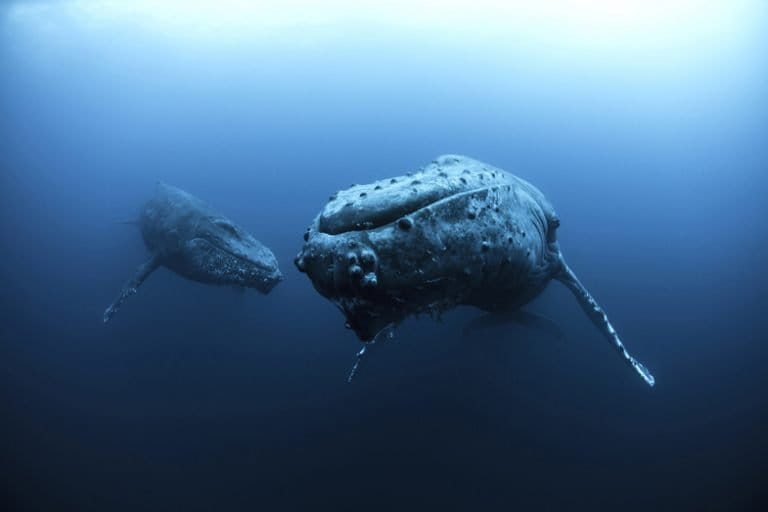- The past couple weeks have brought major news about two important marine protected area projects.
- On November 24, Mexican President Enrique Peña Nieto signed a decree creating the Revillagigedo Archipelago National Park, protecting nearly 150,000 square kilometers (close to 58,000 square miles) from all fishing and extractive activities. It is said to be the largest ocean reserve ever created by Mexico.
- Less than a week later, on the night of November 30, countries including Canada, China, Japan, Russia, and the United States, among others, announced that they had reached an agreement to protect 2.8 million square kilometers (more than 1 million square miles) of the central Arctic Ocean from commercial fishing.
The past couple weeks have brought major news about two important new marine reserves.
On November 24, Mexican President Enrique Peña Nieto signed a decree creating the Revillagigedo Archipelago National Park, protecting nearly 150,000 square kilometers (close to 58,000 square miles) from all fishing and extractive activities. It is said to be the largest ocean reserve ever created by Mexico.
Less than a week later, on the night of November 30, countries including Canada, Denmark, Norway, Russia, and the United States, among others, announced that they had reached an agreement to protect the central Arctic Ocean from commercial fishing.
Mexico announces protections for “The Galapagos of North America”
The protected area Mexico has created around the Revillagigedo Archipelago will be patrolled by the Mexican Navy in the hope that beleaguered populations of marine life can recover from the impacts of commercial fishing.
The decree signed by President Nieto also bans the construction of hotels on the Revillagigedo Archipelago, a group of four uninhabited volcanic islands about 400 kilometers (250 miles) southwest of the Baja California peninsula. The archipelago has been referred to as “the Galapagos of North America” because of its unique ecology, and was named a UNESCO world heritage area last year.

Nieto said in a tweet that the announcement of the ocean reserve “reaffirms the [Mexican Government’s] commitment to the preservation of the heritage of Mexico and the world.”
Con el Decreto del Parque Nacional Revillagigedo, el @gobmx reafirma su compromiso con la conservación del patrimonio de @Mexico y el mundo. pic.twitter.com/RNfTruK6XM
— Enrique Peña Nieto (@EPN) November 25, 2017
Part of a larger range of underwater mountains known as seamounts, the islands create an upwelling of nutrients from the deep sea that a variety of marine organisms rely on, including at least 366 species of fish, 26 of which are endemic to the region and can be found nowhere else on Earth, according to the Pew Charitable Trusts. Some 37 species of sharks and rays also call the archipelago’s waters home, and four different species of threatened sea turtles can be found in marine habitats around Revillagigedo.
Noting that the Revillagigedo Archipelago serves as a “critical waypoint” for migratory species like whales, dolphins, sharks, tuna, and sea turtles, as well as a winter home for humpback whales, Matt Rand, director of the Pew Bertarelli Ocean Legacy Project, welcomed the announcement of the national park.
“We applaud President Peña Nieto’s leadership in protecting the rich waters of Revillagigedo,” Rand said in a statement. “This reserve will protect marine life around the islands and the large migratory species that visit as they traverse the Pacific Ocean; offer a safe haven from many of the pressures humans put on the ocean; and safeguard marine life from the ocean surface to the ocean floor.”
International agreement prevents commercial fishing in Arctic Ocean
After meeting in Washington, D.C., last week, delegates from all five Arctic coastal countries — Canada, Denmark/Greenland, Norway, Russia, and the U.S. — together with China, the European Union, Iceland, Japan, Norway, and South Korea signed a 16-year moratorium on commercial fishing that covers 2.8 million square kilometers (more than 1 million square miles) of the high seas areas of the central Arctic Ocean. That’s an area roughly the size of the Mediterranean Sea, the countries note in the legally binding agreement.

No commercial fishing has ever been known to occur in the area, but it is becoming an ever more likely proposition as global warming leads to an increasingly ice-free Arctic Ocean in summer months. According to Steve Ganey, a senior director at Pew who oversees Arctic marine projects, “The impact of warming waters on this fragile ecosystem is already twice the rate of the rest of the planet. As a result, it is essential to prevent fishing until scientists are able to determine fishing limits that would not harm the ecosystem.”
The agreement establishes a Joint Program of Scientific Research and Monitoring, which aims to improve our understanding of the ecosystems in the central Arctic Ocean’s international waters and, in turn, help determine whether or not fish stocks in the area could ever be harvested sustainably. The moratorium on commercial fishing will be automatically extended every five years until one of the countries objects or a science-based fisheries management plan is put in place.
“It’s a small area, only as big as the Mediterranean, but we see how commercial fishing has affected the Mediterranean already,” Dr. Maria Palomares, Sea Around Us project manager at the University of British Columbia, told Mongabay. “We don’t want to repeat that.”
Jon Burgwald, a political advisor for Greenpeace Nordic, welcomed the agreement to protect the central Arctic Ocean and added that it is now vital that all signatory countries ratify the agreement and commit to long-term protections.
“This is a historic win for Arctic protection and a day for celebration,” Burgwald said in a statement. “We applaud the countries behind this agreement and expect them to make use of the next 16 years to agree on permanent protection for the Central Arctic Ocean — from commercial fisheries as well as from other extractive industries.”



